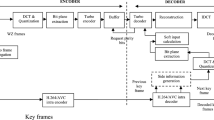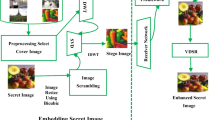Abstract
Video communication gained wide popularity since it offers a more real-time mode of face-to-face interaction. This paper mainly aims to enhance the video transmission quality of multimedia applications via communication network security improvement and an adaptive resource allocation strategy. The main aim of the resource allocation strategy is to achieve efficient usage of spectrum resources since video communication utilizes the orthogonal subcarriers for data transmission and the need for conversion of non-flat channels to flat. An optimized Hybrid Deep Random Neural Network (HDRaNN) architecture is used to overcome the adaptive spectrum resource allocation problem in the single-frequency network transmission by taking into account the different time–frequency resources and regions for overlapping areas and the same time–frequency for non-overlapping areas. The Sheep Flock Optimization algorithm is used to minimize the network error rate of the HDRaNN architecture by optimizing the weights and biases. The basic purpose of communication network security in this paper is to ensure that data communicated over a network connection are safe and secure. The network security protocol offers protection from unauthorized data retrieval and attempts to obtain data. The protocols utilized for secure communication in the proposed technique are Secure Hypertext Transfer Protocol, Secure Socket Layer, Simple Network Management Protocol, and Secure File Transfer Protocol. This protocol also assures that unauthorized users, devices, or services do not have access to your network data and works on all network mediums and data types. The extensive experiments conducted using the proposed methodology show improvements in the video transmission quality in terms of high diversity gain, security, increased throughput, and minimized bit error rate.











Similar content being viewed by others
Explore related subjects
Discover the latest articles, news and stories from top researchers in related subjects.Availability of data and materials
Data sharing is not applicable to this article as no new data were created or analyzed in this study.
Code availability
Not applicable.
References
Kagita MK, Thilakarathne N, Gadekallu TR, Maddikunta PKR (2022) A review on security and privacy of internet of medical things. In: Intelligent Internet of Things for Healthcare and Industry. Springer, Cham, pp 171–187
Moslehi S, Aubrey-Jones D, Knowles M, Obeney-Williams J, Leveson S, Aref-Adib G (2021) Cyberpsychiatry versus COVID-19: using video consultation to improve clinical care in an in-patient psychiatric unit. BJPsych Int. https://doi.org/10.1192/bji.2021.19
Gilbert AW, Booth G, Betts T, Goldberg A (2021) A mixed-methods survey to explore issues with virtual consultations for musculoskeletal care during the COVID-19 pandemic. BMC Musculoskelet Disord 22(1):1–10
Dar K, Bakhouya M, Gaber J, Wack M, Lorenz P (2010) Wireless communication technologies for ITS applications [Topics in Automotive Networking]. IEEE Commun Mag 48(5):156–162
Qiao J, He Y, Shen XS (2018) Improving video streaming quality in 5G enabled vehicular networks. IEEE Wirel Commun 25(2):133–139
Park C, Kim DG, Cho S, Han HJ (2019) Adoption of multimedia technology for learning and gender difference. Comput Hum Behav 92:288–296
Naseer Y, Shah D, Shah T (2019) A novel approach to improve multimedia security utilizing 3D mixed chaotic map. Microprocess Microsyst 65:1–6
Ma S, Zhang T, Wu A, Zhao X (2019) Lightweight and privacy-preserving data aggregation for mobile multimedia security. IEEE Access 7:114131–114140
Stooke A, Achiam J, Abbeel P (2020) Responsive safety in reinforcement learning by pid lagrangian methods. In: International Conference on Machine Learning. PMLR, pp 9133–9143
Guangzhi W (2021) Application of adaptive resource allocation algorithm and communication network security in improving educational video transmission quality. Alex Eng J 60(5):4231–4241
Comşa IS, Molnar A, Tal I, Bergamin P, Muntean GM, Muntean CH, Trestian R (2021) A machine learning resource allocation solution to improve video quality in remote education. IEEE Trans Broadcast 67(3):664–684
Chen J, Wu H, Lyu F, Yang P, Li Q, Shen X (2021) Adaptive resource allocation for diverse safety message transmissions in vehicular networks. IEEE Trans Intell Transp Syst. https://doi.org/10.1109/TITS.2021.3124752
Yu J, Ye X, Li H (2022) A high precision intrusion detection system for network security communication based on multi-scale convolutional neural network. Futur Gener Comput Syst 129:399–406
Li Q, Deng X, Liu Z, Yang Y, Zou X, Wang Q, Xu M, Wu J (2022) Dynamic network security function enforcement via joint flow and function scheduling. IEEE Trans Inf Forensics Secur. https://doi.org/10.1109/TIFS.2022.3142995
Jothi S, Chandrasekar A (2022) An efficient modified dragonfly optimization based MIMO-OFDM for enhancing QoS in wireless multimedia communication. Wirel Pers Commun 122(2):1043–1065
Madarasingha C, Muramudalige SR, Jourjon G, Jayasumana A, Thilakarathna K (2022) VideoTrain++: GAN-based adaptive framework for synthetic video traffic generation. Comput Netw 206:108785
Pérez-Bueno F, García L, Maciá-Fernández G, Molina R (2022) Leveraging a probabilistic PCA model to understand the multivariate statistical network monitoring framework for network security anomaly detection. IEEE/ACM Trans Netw. https://doi.org/10.1109/TNET.2021.3138536
Reyes RR, Bauschert T (2017) Adaptive and state-dependent online resource allocation in dynamic optical networks. J Opt Commun Netw 9(3):B64–B77
Kwon T, Cho DH (2008) Adaptive-modulation-and-coding-based transmission of control messages for resource allocation in mobile communication systems. IEEE Trans Veh Technol 58(6):2769–2782
Hadi M, Pakravan MR, Agrell E (2019) Dynamic resource allocation in metro elastic optical networks using Lyapunov drift optimization. J Opt Commun Netw 11(6):250–259
Tang L, Tan QI, Shi Y, Wang C, Chen Q (2018) Adaptive virtual resource allocation in 5G network slicing using constrained Markov decision process. IEEE Access 6:61184–61195
Tang L, He X, Yang X, Wei Y, Wang X, Chen Q (2019) ARMA-prediction-based online adaptive dynamic resource allocation in wireless virtualized network. IEEE Access 7:130438–130450
Singkibud P, Mukdasai K (2022) Robust passivity analysis of uncertain neutral-type neural networks with distributed interval time-varying delay under the effects of leakage delay. Int J Math Comput Sci 26:269–290
Kumar P, Panwar V (2022) Wavelet neural network based controller design for non-affine nonlinear systems. J Math Comput Sci 24(1):49–58
Mahmood K, Akram W, Shafiq A, Altaf I, Lodhi MA, Islam SH (2020) An enhanced and provably secure multi-factor authentication scheme for Internet-of-Multimedia-Things environments. Comput Electr Eng 88:106888
Almasalha F, Naït-Abdesselam F, Trajcevski G, Khokhar A (2018) Secure transmission of multimedia contents over low-power mobile devices. J Inf Secur Appl 40:183–192
Xiao K (2021) Construction of embedded secure terminal and multimedia database based on trusted computing technology and wireless network. Alex Eng J 60(5):4223–4230
Mishra D, Rana S (2021) A provably secure content distribution framework for portable DRM systems. J Inf Secur Appl 61:102928
Abunadi I, Abdullah Mengash HS, Alotaibi S, Asiri MM, Ahmed Hamza M, Zamani AS, Motwakel A, Yaseen I (2022) Optimal multikey homomorphic encryption with steganography approach for multimedia security in internet of everything environment. Appl Sci 12(8):4026
Nassar SS, El-Bendary MA (2022) Confidentiality considerations: multimedia signals transmission over different wireless channels utilized efficient secured model. Multimed Tools Appl. https://doi.org/10.1007/s11042-022-12297-1
Sharma N, Chakraborty C, Kumar R (2022) Optimized multimedia data through computationally intelligent algorithms. Multimed Syst. https://doi.org/10.1007/s00530-022-00918-6
Huma ZE, Latif S, Ahmad J, Idrees Z, Ibrar A, Zou Z, Alqahtani F, Baothman F (2021) A hybrid deep random neural network for cyberattack detection in the industrial internet of things. IEEE Access 9:55595–55605
Suresh S, Dong K, Kim HJ (2010) A sequential learning algorithm for self-adaptive resource allocation network classifier. Neurocomputing 73(16–18):3012–3019
Kivi ME, Majidnezhad V (2022) A novel swarm intelligence algorithm inspired by the grazing of sheep. J Ambient Intell Humaniz Comput 13(2):1201–1213
Radley S (2020) Programmed routing in the direction of MST by virtue of port dependent decision device. i-Manager’s J Commun Eng Syst 9(1):8
Banerjee S, Patil A, Jadhav D, Borkar G (2022) Digital forensics as a service: analysis for forensic knowledge. In: Cyber security and digital forensics, pp127–162
Bitton R, Shabtai A (2019) A machine learning-based intrusion detection system for securing remote desktop connections to electronic flight bag servers. IEEE Trans Dependable Secure Comput 18(3):1164–1181
Li J, Jia Y, Liu L, Wo T (2013) CyberLiveApp: a secure sharing and migration approach for live virtual desktop applications in a cloud environment. Futur Gener Comput Syst 29(1):330–340
Zhang Y, Li P, Wang D, Zheng W (2006) Seamless peripherals integration for network computers based on the reversed server message block protocol. In: International conference on Networking and Services (ICNS'06). IEEE, pp 112–112
Funding
Not applicable.
Author information
Authors and Affiliations
Corresponding author
Ethics declarations
Conflict of interest
The authors declare that they have no conflict of interest.
Consent to participate
Not applicable.
Consent for publication
Not applicable.
Human and animal rights
This article does not contain any studies with human or animal subjects performed by any of the authors.
Informed consent
Informed consent was obtained from all individual participants included in the study.
Additional information
Publisher's Note
Springer Nature remains neutral with regard to jurisdictional claims in published maps and institutional affiliations.
Rights and permissions
Springer Nature or its licensor (e.g. a society or other partner) holds exclusive rights to this article under a publishing agreement with the author(s) or other rightsholder(s); author self-archiving of the accepted manuscript version of this article is solely governed by the terms of such publishing agreement and applicable law.
About this article
Cite this article
Benisha, R.B. An efficient Sheep Flock Optimization-based hybrid deep RaNN for secure and enhanced video transmission quality. Neural Comput & Applic 35, 8065–8080 (2023). https://doi.org/10.1007/s00521-022-08083-7
Received:
Accepted:
Published:
Issue Date:
DOI: https://doi.org/10.1007/s00521-022-08083-7




